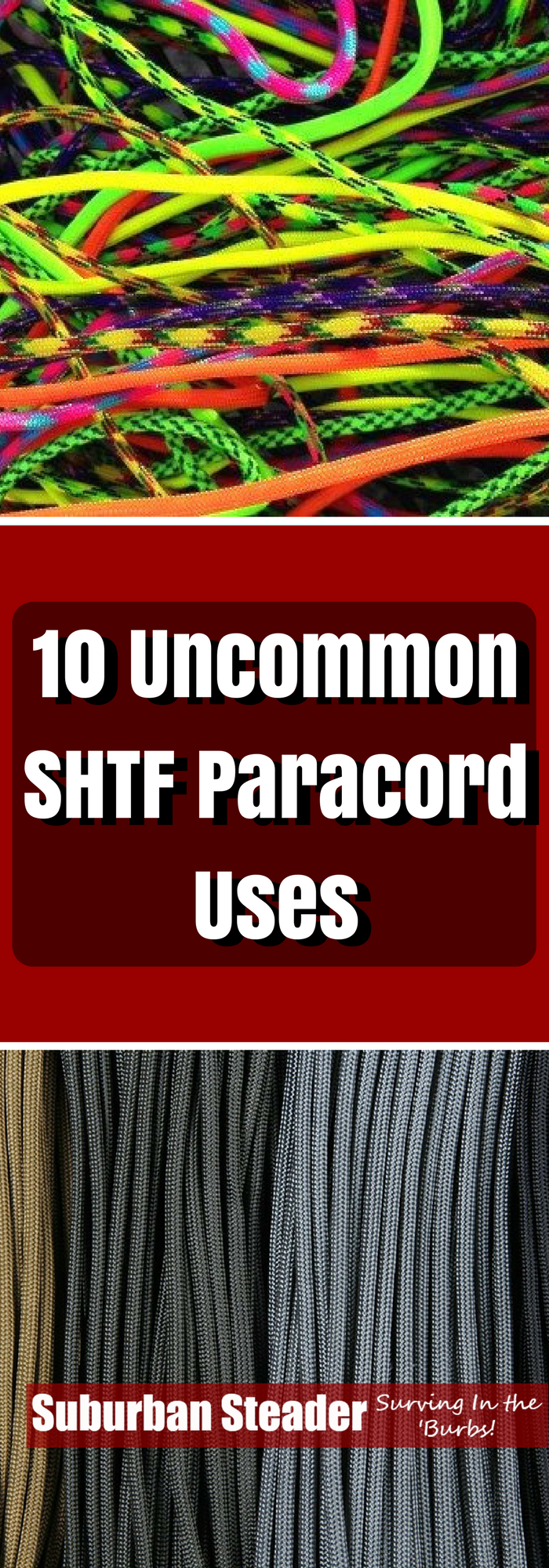10 Uncommon SHTF Paracord Uses
I don’t know anyone involved with preparedness and survival that hasn’t heard of, seen or even purchased paracord. Be it a survival bracelet or a 100ft coil, you stow it in your Bug Out Bag for an emergency situation.
I am a strong believer that you should know HOW to use each and every single piece of gear in your pack before you need it. There is no point trying to learn on the job, so to speak. That approach could mean all of your best-laid plans fail because you didn’t invest the time upfront.
In this article, we will take a look at 10 uncommon uses for paracord. They are easy to do and I recommend you try some of them out once you’ve finished reading.
They could save your life one day.
Where To Get High-Quality Paracord?
Getting a “good deal” on survival equipment should be a secondary consideration – Quality is the primary concern. You need to be able to trust the paracord you have and you do that by buying high-quality paracord.
There are a lot of vendors out there for paracord. I support my local shop most of the time and you should too if you have the option. If you don’t have any paracord close by, then check out Amazon for 100-foot sections at a good price.
Let’s get to the paracord projects!
Project #1 – Fishing Lure
Procuring food will be high on the agenda if you decide to bug out or when the delivery trucks stop running. Feeding yourself and your family will be a skill that every man and woman will need if they are to survive.
Fishing is one of the ‘easiest’ forms of catching food, plus it expends very few calories when compared to stalking, hunting and trapping animals for example.
Not only can paracord be used as a fishing line, but also a lure. A Lure is used to attract the attention of the fish and is a kind of Trojan horse, in that it’s designed to be something it is not and hidden in plain sight.
In the video above, you can see how she frays the ends and each strand of the cord to make it more attractive to the fish and to look like bait.
Project #2 – Fishing Line
That’s not all those small inner stands are great for, you can also make an improvised fishing rod and a line from a long piece of wood and a few meters of an inner stand that has been split down to it’s single most thread.
Combine this with the fishing lure mentioned above and you have everything you need for a spot of fly-fishing.
Project #3 – Paracord Net
During a SHTF event, a net made from paracord can be used for a number of applications, such as:
- Gear and vehicle concealment
- Catching fish, turtles and other food
- Shelter roofing to add leaves and other materials
- A hammock
The examples above a just a few ways to make use of a paracord net, watch the video below to find out how to make one from scratch.
Project #4 – Sutures
Most top-grade paracord has at least five strands, most of the time you will find seven small strands enclosed within the outer casing. These inner strands are what provide the strength to the paracord.
On their own, they are tough but fairly weak. However, combine them and you have some seriously strong stuff. The outer casing itself is weak and shouldn’t be separated from the inner strands and used to bear any weight alone.
One of the great uses in a SHTF situation is to remove one of those inner strands, which can then be split down even further to make a thread that is thin enough to thread through the eye of a needle.
If you have an open wound that needs to be closed up, you can use this to do so, whilst this is only a temporary measure, you will feel like Rambo afterward!
It is easy to make these smaller strands by taking just a single length of inner paracord strand, and twisting it between your fingers until the 2 smaller stands come away from each other. They can then be spliced apart easily.
Project #5 – Sewing and Gear Repairs
By using the same method used in the last section to create small thin strands, which have a load capacity of around 25lbs each, you can perform running repairs on your gear.
Think about it, you have a pack full to the brim, bursting with all the gear you need to survive. Now say you snag the pack on a branch and it tears open, or one of the straps breaks under the heavy load.
You can use these smaller inner strands of cord to sew your gear back together and get on with the task in hand.
Obviously this will require you to have some sewing needles in your pack or on your person, however, you can improvise by using a stick that has been sharpened to a point and simply tie the cord onto the end.
There is a downside to this however in that the holes in your gear will be larger and make the attachment points weaker.
Project #6 – Snares and Traps
I also mentioned trapping as a low-calorie expending way to catch your dinner. Setting snares and traps is a great way to spend some time when out in the wilderness in a survival situation.
You may have seen these spring-loaded traps before. In the video above, the young man uses string. Depending on the type of animal you are aiming to catch, paracord is much better suited due to its high breaking strength.
Project #7 – Replacement Boot Laces
Even if you have a bug out vehicle, the chances are you are going to have to spend some time on foot getting to your bug out location and/or protecting your home from opportunistic looting.
A good pair of sturdy tactical boots are perfect and will last a good few years if looked after. However, it’s the boost laces that often are the first point of failure I footwear.
They can get snagged, you can pull them too hard and they break. They degrade over time from the water, dirt, strain and the general wear and tear you put on them.
Paracord is a perfect replacement for your shoelaces. In fact, I swap out my laces each time I buy a new pair of boots for that very reason. It will stand up to pretty much anything you can throw at it and it can also be used for several other things such as the fishing lure I mentioned above.
Simply snip off one end to make the lure, and you still have enough lace to tie off your boots.
Project #8 – Splint, Sling, and Tourniquets
A broken finger, or any bone for that matter, in a SHTF situation is amplified by ten because of the situational requirements on you when you need your body to be fully alert and functional.
A broken finger, whilst painful, is also manageable. To aid the healing process and to prevent further damage, simply wrapping the broken finger and the finger next to it with paracord will act as a splint that will be strong and sturdy enough to provide support.
Should you be unlucky enough to break your leg, you can also use paracord and a thick branch, about the thickness of your wrist, to support the leg.
If you have a broken arm, however, you are in trouble and you need to get that arm secure and out of the way, again to prevent further damage.
By wrapping the paracord around the broken area a few times and then looping it around the neck and over your shoulder, you can have a makeshift sling.
If you have a large wound or have a member of your group who is losing a lot of blood, the first thing to apply is a tourniquet. Which, can be improvised by using a single length of paracord, tied off above the wound and then using a small stick, you twist the paracord to tighten against the leg and slow the loss of blood.
Project #9 – Bow Drill String
Making fire by friction is a skill all preppers and survivalist should possess. This is one skill that required practice and a lot of patience.
There is a great feeling of accomplishment when you complete your first friction fire. That’s not to mention the feeling of comfort and safety that comes from within, knowing you have the skill to keep making something that can keep you warm, cook your food and purify your water.
You can use paracord to make the bow section of your bow drill set, as it is strong enough to withstand the pressure exerted by the drill.
Fire, or as woodsmen call it…the outdoors TV is truly a remarkable survival tool.
Project #10 – Vehicle Hose Clamp
If you’re bugging out by vehicle and one of the clamps on the hoses in your engine fails, you can use paracord to cinch down tightly around the hose which will hold it in place until you can make a full repair when appropriate.
In fact, there are many uses for paracord with vehicles such as securing items to your roof and even to dip into the gas tank to soak up extra fuel which can then be wrapped around a stick for a torch or to help get a fire going in less than ideal conditions.
Conclusion
I hope you got a few new ideas about what you can do with paracord. It isn’t just for making colorful bracelets! You should be developing your skills with paracord all the time so when you really need them, you can work effectively under pressure. That is what survival and prepping is all about.
What is your next paracord project? Let me know in the comments below.


